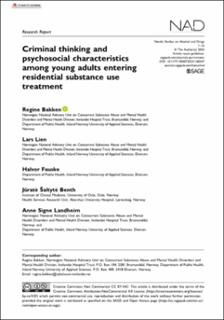| dc.contributor.author | Bakken, Regine | |
| dc.contributor.author | Lien, Lars | |
| dc.contributor.author | Fauske, Halvor | |
| dc.contributor.author | Saltyte Benth, Jurate | |
| dc.contributor.author | Landheim, Anne Signe | |
| dc.date.accessioned | 2023-10-17T06:48:00Z | |
| dc.date.available | 2023-10-17T06:48:00Z | |
| dc.date.created | 2023-06-12T13:29:17Z | |
| dc.date.issued | 2023 | |
| dc.identifier.citation | Nordic Studies on Alcohol and Drugs (NAD). 2023, . | en_US |
| dc.identifier.issn | 1455-0725 | |
| dc.identifier.uri | https://hdl.handle.net/11250/3096832 | |
| dc.description.abstract | Background and aim: Young adults with substance use (SU) problems face a high risk of co-occurring problems, including criminality. The aim of the present study was to assess the psychosocial characteristics, SU problems, and criminal thinking young adults entering SU treatment have, and whether the SU characteristics, sex and age are associated with criminal thinking scores. Methods: The sample was 407 young adults aged 16–29 years who underwent an entry assessment between January 2011 and December 2016 at a residential SU treatment institution in Norway. All study data were extracted from electronic health records, including survey information from the Achenbach System of Empirically Based Assessment and the Psychological Inventory of Criminal Thinking Styles. Results: In the present sample, severe SU, high rates of psychosocial problems, and criminal thinking were reported. Almost three-quarters (72.67%) of young adults reported high levels of criminal thinking (≥60). However, male participants were more likely to report high levels of criminal thinking compared to female participants (p=0.031). In bivariate regression models, only sex and having stimulants/opioids as primary drug were associated with mean levels of criminal thinking. The same was true in the multiple regression model. Conclusion: Young adults in residential SU treatment are a multi-problem high-risk/high-need group of people. Due to the elevated levels of criminal thinking, we recommend that young adults in SU treatment should be screened for criminogenic treatment needs, such as criminal thinking, regardless of justice involvement. | |
| dc.language.iso | eng | en_US |
| dc.rights | Navngivelse-Ikkekommersiell 4.0 Internasjonal | * |
| dc.rights.uri | http://creativecommons.org/licenses/by-nc/4.0/deed.no | * |
| dc.title | Criminal thinking and psychosocial characteristics among young adults entering residential substance use treatment | en_US |
| dc.title.alternative | Criminal thinking and psychosocial characteristics among young adults entering residential substance use treatment | en_US |
| dc.type | Peer reviewed | en_US |
| dc.type | Journal article | en_US |
| dc.description.version | publishedVersion | |
| dc.source.pagenumber | 16 | en_US |
| dc.source.journal | Nordic Studies on Alcohol and Drugs (NAD) | en_US |
| dc.identifier.doi | 10.1177/14550725231160337 | |
| dc.identifier.cristin | 2153793 | |
| cristin.ispublished | true | |
| cristin.fulltext | original | |
| cristin.qualitycode | 1 | |

